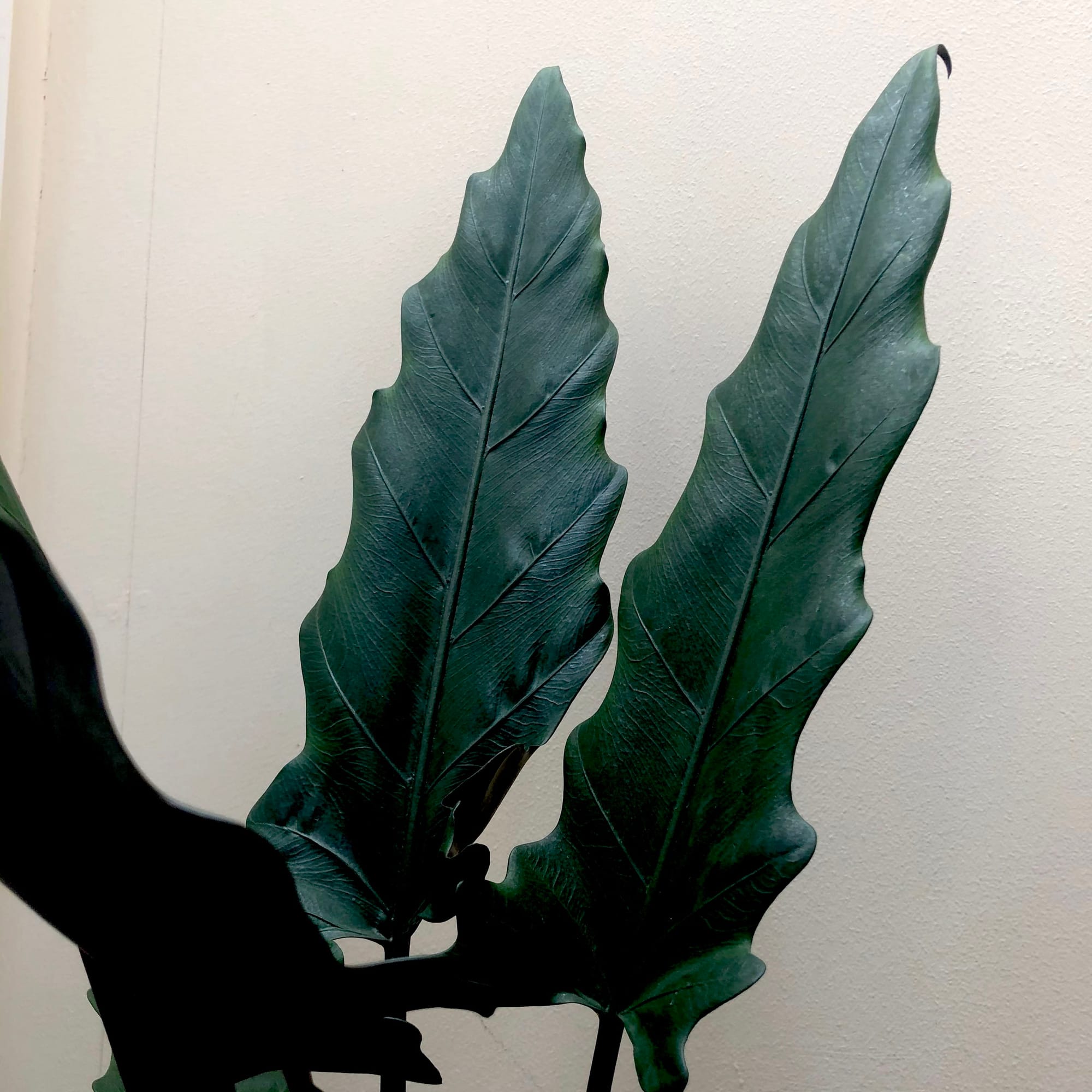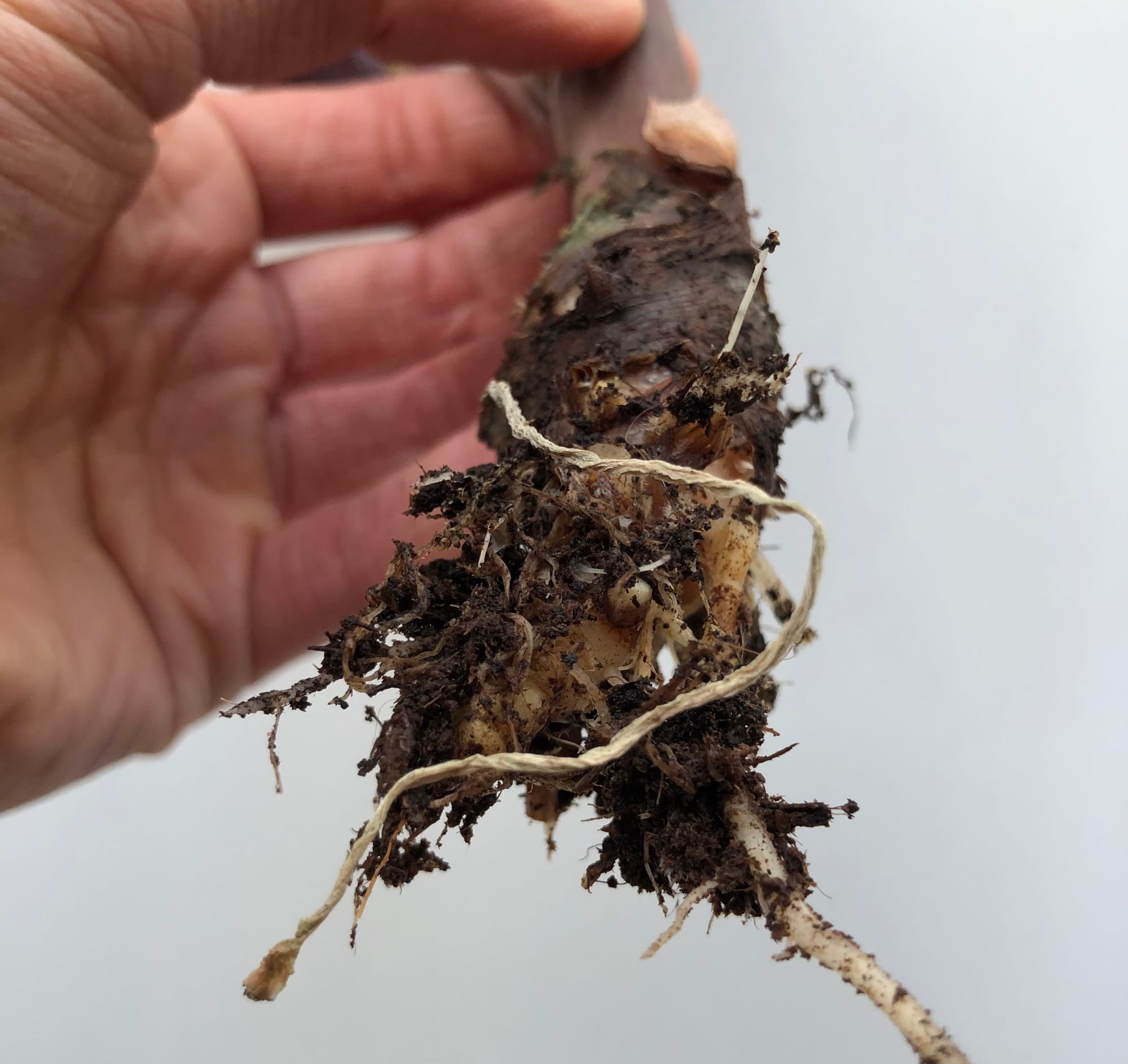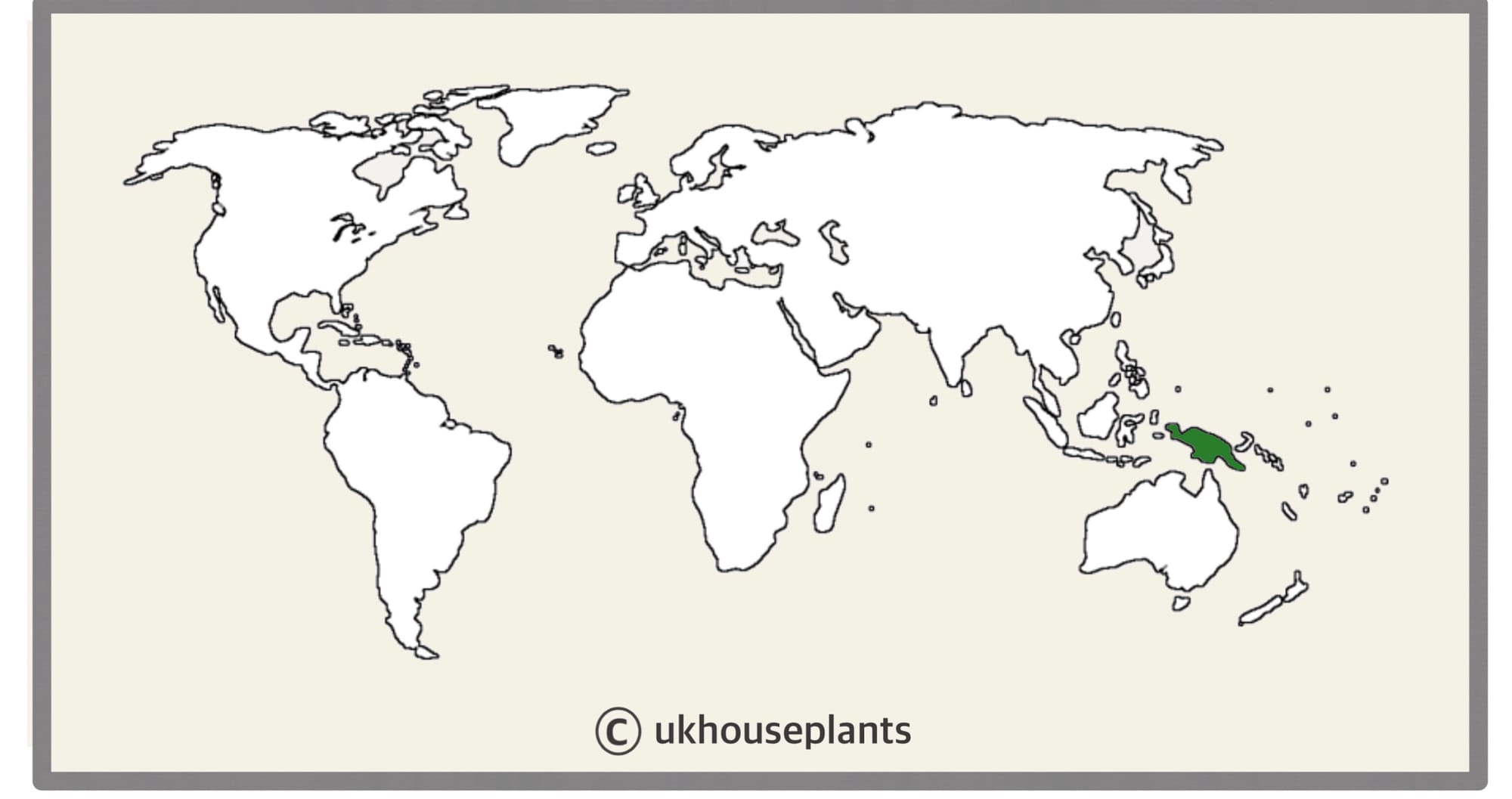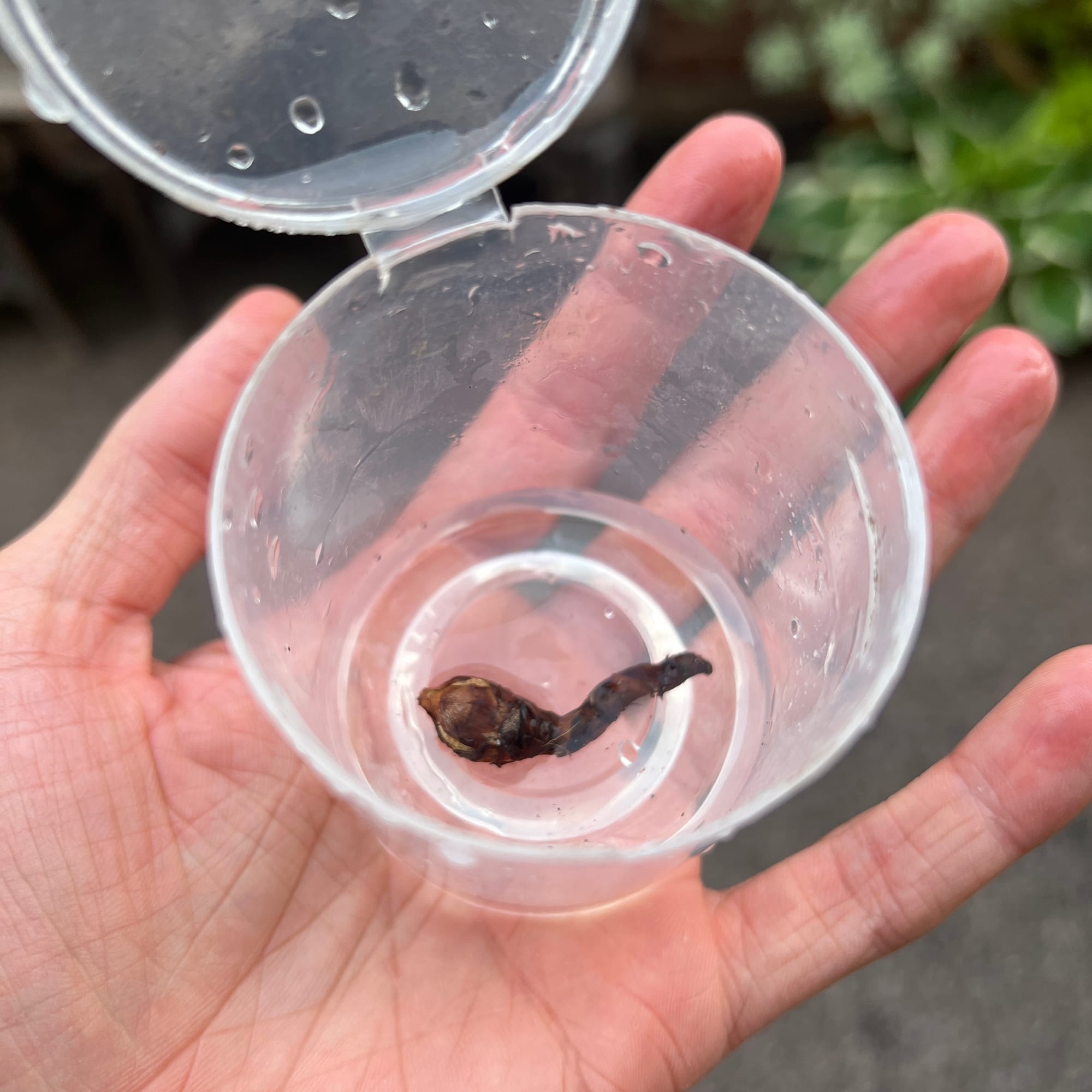
Alocasia lauterbachiana
Contents
- Top Tips
- Location, Water, Humidity & Fertilisation
- Common Issues
- Origins, Temperature, Propagation, Repotting & Toxicity.
Need the answer to a specific plant query? Book a 1-to-1 video call with THE HOUSEPLANT DOCTOR™ the website's friendly author, to overcome and address your niggling problem! Available on iMessage, WhatsApp, Facebook Messenger & more.
Top Tips & Info
- Care Difficulty - Moderate
- Alocasia lauterbachiana grow best in spots that can provide near-perfect overhead lighting; within 2m of a window or in a semi-shaded conservatory are best for its overall health.
- Rehydrate the soil once the top third dries out, using lukewarm water to avoid shocking the roots.
- Introduce a humidity tray while the heaters are operating to maintain regular levels of humidity.
- Fertilise using a 'Houseplant' labelled feed every three waters in the spring and summer, reducing this to every fourth water in the colder months.
- Keep an eye out for Spider Mites and Mealybugs that'll live under the leaves and between the stem.
- Wash or dust the foliage monthly to increase the light-capturing efficiency and photosynthesis, which will benefit the plant's overall health.
- Repot every two or three years using a 'Houseplant' labelled potting mix. Avoid pulling the soil from its roots as 'Transplant Shock' can have fatal consequences for your plant.
Location & Light - 🔸🔸🔸
Alocasia are best situated in a bright location that boasts overhead light, but if you can't provide this, within two metres of a window will still do the job - albeit slower growth. Those situated in a shadier location must have their leaves rinsed from time to time to improve the light-capturing efficiency. Never allow it to sit in strong sunlight for more than three hours a day, as too much light will result in a pale, washed-out appearance with possible brown patches.
If it were up to us, we would locate our plant in a windowsill. A north, east, or west facing window is fantastic for good quality growth, or under a grow-light for optimum growth.
Water - 🔸🔸
Allow the top third of the soil dry out in between waters during the active growth period, reducing this further in the autumn and winter. Due to the sensitivity of their root systems, never apply cold water as it may weaken its health and well-being over time. For those that use tap water (instead of rainwater or fresh bottled water), allow it to stand for at least 24hrs to settle the high levels of chloride and fluoride found from the tap. Under-watering symptoms include wilting, little to no growth and greying leaves - these issues are commonly down to too much light/heat, or forgetfulness. Alternatively, over-watering symptoms include rapidly yellowing lower leaves, wilting (root rot), brown spots on leaves, and a rotten stem. Specimens that are located in a darker area are more likely to adopt root rot as the soil may not dry out sufficiently in between waters. Remember - under-watering is far better than over-doing it, due to the species' corm that can retain moisture in times of short-lived droughts.
Humidity - 🔸🔸
Average room humidity will be accepted by an Alocasia, but remember to introduce a pebble tray while the heaters are operating to counteract dry air. A quick monthly hose down in the shower will hydrate the leaves, eliminate dust particles and help reduce numbers of pests, most notably Spider Mites.
Fertilisation - 🔸🔸
Fertilise every three waters in the spring and summer, reducing this to every four in the colder months. Either use a 'Houseplant' labelled fertiliser, or a 'General Plant' feed at half strength. Never apply an RTU (Ready to Use) product without a quick drink of water beforehand, due to the heightened risk of chemical root burn. Regular supplements are essential for reliable growth during the spring and summer months, as stunted growth could be a cause of irregular feeds.
Common Issues with Alocasia
An array of simultaneous cultivation issues will increase the chance of developing yellowed leaf-sections with browned halos. Firstly, the location may be too dark, with its compost staying too saturated in-between waters; if mould is growing across the soil, this is usually a bad sign. Further, you're potentially using too cold water or tap water that hasn't been allowed to sit for 24hrs. If the specimen hasn't been nourished in over two months, it'll begin to show signs of nutrient deficiencies seen in this article.
If this common problem has occurred with your specimen, remove the affected leaves (not areas) and improve the growing conditions considerably. Fertilise regularly with lukewarm water and be sure to allow the top third to dry out in between hydrations.
If your Alocasia begins to wilt, it could be the product of one or many issues, ranging from the environment to your care habits. If the specimen is located in too low light, it may lead to plant-confusion when the window is several metres away. As mentioned in 'Location & Light', most Alocasia will require overhead lighting to complement its growth habit, with anything else causing either wilting or slanted growth. Secondly, irregular watering habits could cause root dehydration, which will eventually lead to wilting. Prolonged droughts will result in a lack of hydration in the upper part of the plant, with root rot doing the same - albeit it with overly soggy compost. Finally, environment shock could be the final culprit of your wilting Alocasia. If the specimen has recently been purchased or relocated, the chances are that the specimen hasn't acclimated itself to the new environment. Be sure to provide a bright, indirect setting with the best possible angle to the light source (overhead or nearby a window). Maintain relatively moist soil, allowing the top third to dry between waters and fertilise every two to four weeks, depending on the current season. If you still have questions about your poorly Alocasia, be sure to book a 1-to-1 Call with THE HOUSEPLANT DOCTOR™ to discuss this further!
Leggy or spindly leaves/stems that can easily snap are the result of low light. Increase your plant's light levels by relocating it to within 2m (6ft) of a window that offers up to two hours of early morning (before 9am) or evening sunlight (after 7pm). Don't prune the already-leggy foliage and instead wait for more compact growth that may take up to two months to grow. Feed regularly and maintain reliable soil moisture.
If your specimen develops basal collapse, it may spell the end of its life. The corms, which are located below the soil line and act like a modified stem, are the lifeline for a successful specimen, so any issues of rot will kill it outright. If yours has problems of this, be sure to take the plant out of the pot and inspect its roots and base. Prune away any rotten areas and check its base for a softened profile. Remove any individual plants that have a rotten bottom and repot the healthy specimens in a fresh batch of 'Houseplant' compost. Provide a brighter location and reduce the number of waters slightly to avoid further rot. Discard the plant if there is no sign of health below the soil line, especially if its base is mushy and hollow.
Regular waters and fertilisations are essential. Periods of droughts will quickly slip the Alocasia back into its dormancy period, thus causing stunted growth and a bewildered plant owner. If it hasn't repotted in a while, there may be too many roots and not enough soil to retain moisture, thus leaving the compost to dry out quicker. Click on this link to learn more about a transplant.
Pests could arise at any time, with infestations starting from the original nursery or via contamination in your home. Spider Mites and Mealybugs to tend to be the usual inhabitants, with the first being minute and almost transparent, roaming the leaves in search of chlorophyll and a site to hide its eggs. The latter, however, will stand out much more, with white cottony webs developing across the foliage and stems. Thoroughly check the plant's cubbyholes before giving it the all-clear, or click on the appropriate links to learn more about eradicating these issues!
 Alocasia can be riddled with pests due to its thin, broad leaves. In the image above, there's a third point of interest to look at - mineral/calcium deposits. This is a natural part of an Alocasia leaf's lifecycle, so don't worry about removing them!
Alocasia can be riddled with pests due to its thin, broad leaves. In the image above, there's a third point of interest to look at - mineral/calcium deposits. This is a natural part of an Alocasia leaf's lifecycle, so don't worry about removing them!
The rapid yellowing of older leaves and a wobbly plant are a clear sign of over-watering, usually caused by too little light. Although Alocasia can do well in darker locations, the frequency of irrigations must be reduced to counteract the chance of root rot. People don't realise that a plant's root system needs access to oxygen too; when soil is watered, the air will travel upwards and out of the potting mix. A lack of accessible oxygen for the roots will cause them to subsequently breakdown over the oncoming days. Click on this link to learn more about root rot and how to address it, and always feel the pot's weight for confirmation (heaviness = good soil moisture, & vice versa).
Too low humidity can cause excessive browning tips with yellow halos. Although this won't kill your specimen, you may want to increase the local moisture to prevent the new growth from adopting these symptoms. Mist or rinse the foliage from time to time and create a humidity tray while the heaters are active to create a stable environment. Browning leaf tips are an inevitable part of a leaf's maturity though, so never be too disheartened if your specimen is showing signs of this!
Clean the leaves regularly. Although this isn't too much of an issue, a build-up of dust particles can clog up the plant's pores, causing lowered light capturing-efficiency. Rinse the topsides of the leaves down once a month to keep levels down and improve growing conditions.
Mould or mushrooms developing on the soil means two things - too little light and over-watering. Despite the harmlessness, it'll prove unsightly to most gardeners and is therefore removed once known. To remove, replace the top two inches of the soil for a fresh batch of 'Houseplant' compost. Either increase the amount of light received (no direct sunlight for the first few weeks to prevent environmental shock) or decrease the frequency of waters slightly. If the mould is accompanied by yellowing lower leaves, you may also have a case of root rot.
There are several species of Leaf-Spot Disease, (Graphiola, Botrytis, Anthracnose & Cercospora) and all of them operate in the same way. Fungi spores will land on the leaf's surface and will slowly develop along with the plant. Unfortunately, as there aren't any products that'll address the issue head-on, you can only remove the affected areas and regularly wash the leaves to limit the spread. In some cases, however, the small yellow spots are caused by inconsistent soil moisture and are not the direct product of a disease. Think about your own cultivation habits and make a decision on what to do.
Other yellowing leaves - it isn't easy to accurately pinpoint why this is happening as it could be due to many different reasons. If the lower leaves are yellowing in quick concession, it could be over-watering. Do not allow the soil to become soggy or waterlogged; failure to do so will cause root or corm rot and possible death (see image below). For severe cases, take the plant out of rot pot to examine for root rot - a transplant may have to be performed. The second reason why its leaves are yellowing could be due to either too much sunlight or not enough water. As mentioned above, under-watering can cause an Alocasia to slip into its dormancy period. Still, persistent droughts with direct sunlight will cause further damage in the likes of yellowing leaves, stunted growth and wilting.
 A key symptom of over-watering (especially those grown in low light) may suffer from corm rot as seen above. In this case, we recommend to prune off each rotten/brown root & repot into a smaller pot with fresh 'Houseplant' potting mix. Relocate if necessary.
A key symptom of over-watering (especially those grown in low light) may suffer from corm rot as seen above. In this case, we recommend to prune off each rotten/brown root & repot into a smaller pot with fresh 'Houseplant' potting mix. Relocate if necessary.
Origins
This species was originally named 'Schizocasia lauterbachiana' until the 1970s-80s, when Australian botanist, Alistair Hay, reclassified it under Alocasia. A. lauterbachiana has natural distributions across Indonesia's Papua New Guinea and nearby islands of New Britain and New Ireland. The specific epithet, Lauterbachiana, honours German botanist, Carl Adolf Georg Lauterbach, a close friend to Adolf Engler - the man who originally placed the species in Schizocasia in the nineteenth century.
 The Distribution of Alocasia lauterbachiana
The Distribution of Alocasia lauterbachiana
Temperature
10° - 30°C (50° - 86°F)
H1b (Hardiness Zone 12) - can be grown outdoors during the summer in a sheltered location with temperatures above 12℃ (54℉), but is fine to remain indoors, too. If you decide to bring this plant outdoors, don't allow it to endure any direct sunlight as it may result in sun-scorch and dehydration. Regularly keep an eye out for pests, especially when re-introducing it back indoors.
Spread
Over 1.8m in height and 0.7m in width once the specimen reaches maturity. The ultimate height will take between 6 - 8 years to achieve, with several new leaves grown per year.
Pruning & Maintenance
Remove yellow or dying leaves, and plant debris to encourage better-growing conditions. While pruning, always use clean utensils or shears to reduce the chance of bacterial and fungal diseases. Never cut through yellowed tissue as this may cause further damage in the likes of diseases or bacterial infections. Remember to make clean incisions as too-damaged wounds may shock the plant, causing weakened growth and a decline in health.
Propagation
Via Seed, Corm or Stem Cutting Propagation
Seeds (Difficult) - This form of propagation isn't common due to the difficulties growers might face trying to source seeds. For those who have the seeds ready, submerge the Alocasia seeds around 1cm deep in an 'Alocasia' labelled potting mix in a seed tray. Maintain reliable soil moisture and provide a bright, sunless windowsill while they germinate. You can separate the seedlings into individual 5cm pots once they produce their third leaf.
Corms (Easy to Moderate) - Most Alocasia are have corms, which are small globular-shaped brown bulbs that'll grow along the root system. A mature Alocasia can produce over ten corms at any time and can be harvested when you next repot it. Here's how to do it;
- The best time to repot is during the spring or early summer. Make sure that a few hours before repotting, you water the plant's soil to reduce the risk of 'transplant shock' when the roots are disturbed in dry soil.
- Take the mother plant out of its pot and gently work your fingers through the rootball (& soil) until you feel the small brown ball-shaped 1-2cm corms. Have a look at the image below for what they look like!
- With a clean pair of scissors or a knife, cut off the corm via the 'rhizome' (root) that attaches it to the mother's root system. Make sure around 0.5cm+ of the 'rhizome' is still attached to the corm, so don't prune too close to the bulb itself. Have a look at the images below.
- Once separated, place the corm sideways in a small glass (like a shot glass) or plastic cup. Pour around 20ml of water, so it creates a small puddle of water which should submerge around 10% of the corm. Do not fully submerge the corm as this could result in it rotting. Place the corm (in its container) in a warm, bright windowsill until roots develop which will take between 2-8 weeks. Replace the water twice a week to remove any bacteria. See the image below.
- One the roots are around 3cm (1in) in length (pictured below), plant it in fresh 'Alocasia' labelled potting mix in a 5-7cm plastic pot.
- With the mother plant, repot her back into its orignal pot with a fresh batch of 'Alocasia' labelled potting mix. If you're growing the mother Alocasia in hydroponics, repot this back into the same pot with fresh potting medium.

This is how you 'puddle' an Alocasia corm by submerging it in water to root. Never submerge the entire corm in water as this increases the likelihood of it rotting.
 Extra Tip: A healthy corm should be solid when pinched. Discard any bulbs that are softened or rotten as the bacteria will kill the whole corm.
Extra Tip: A healthy corm should be solid when pinched. Discard any bulbs that are softened or rotten as the bacteria will kill the whole corm.
 Here's a corm that THE HOUSEPLANT DOCTOR™ has grown hydroponically and is now ready to be planted in either soil or moss. (He recommends Sphagnum Moss as a good growing medium).
Here's a corm that THE HOUSEPLANT DOCTOR™ has grown hydroponically and is now ready to be planted in either soil or moss. (He recommends Sphagnum Moss as a good growing medium).
Stem Cuttings (Moderate) - For older Alocasia that are over four years old, they'll produce offshoots along its wooded stem. These little branches can be propagated when pruned off and grown as their own individual plant. Here's what to do;
- Only choose offshoots along the stem that have at least two leaves. Those with less than two leaves (or even none) may not root.
- With a clean knife, cut the offshoot along the stem so the cutting has as much stem as possible.
- Once separated, choose between placing the cutting directly in water to root, or by dipping the wound in rooting gel before planting straight into soil. If you have chosen to root directly in water, make sure to replace the water once every week and place in a 12cm pot with 'Houseplant' labelled soil once the roots surpass 5cm in length. (While rooting, don't submerge any of its foliage in water - only its stem!)
For those who are directly planting the rootless cuttings/offsets in soil, dip the wound (where it has been cut off) in rooting gel before planting it in a 12cm pot with 'Houseplant' labelled potting mix. Once potted-up, water the soil until it has become moist and wrap the cutting (its pot AND foliage) in a transparent plastic bag with a few holes for aeration. The bag will lock in humidity around the cutting and will reduce the risk of dehydration (common with tropical cuttings). Keep the soil moist by checking it twice a week. Once the plant has produced two more leaves while in the bag, remove the bag and treat like a mature specimen. - For either method of propagation, always ensure your cutting is kept in a bright, indirect location with no risk of sunlight. Warm temperatures above 20℃ (68℉) throughout this period is vital for success, too!
Flowers
As this species is part of the Araceæ family, their inflorescences aren't showy. Much like a Peace Lily's flower, their flowers consist of a white or green spathe (the spoon-like shell) with the spadix being the site of pollination. Blooms can last up to three days and are usually visible during late spring or early summer around 30cm+ from the soil line.
In some cases, a show of flowers may indicate the plant is stressed; common causes of this are irregular waters, root rot and environmental shock.
Repotting
Repot every two or three years in the spring, using a 'Houseplant' labelled potting mix and the next sized pot with adequate drainage. Alocasia are far better being potbound for several years due to the heightened risk of root rot and repotting-issues (like transplant shock, which will result in yellowed leaves and wilting), so only repot if you feel it's wholly necessary.
Hydrate the plant 24hrs before tinkering with the roots to prevent the risk of transplant shock. For those situated in a darker location, introduce an extra amount of perlite and grit into the new soil to downplay over-watering risks. Click on this link for a detailed step-by-step guide on transplantation, or via this link to learn about repotting with root rot.
Book a 1-to-1 video call with THE HOUSEPLANT DOCTOR™ if you'd like a personal guide to repotting your houseplant. This will include recommending the right branded-compost and pot size, followed by a live video call whilst you transplant the specimen for step-by-step guidance and answer any further questions!
Pests & Diseases
Keep an eye out for mealybugs, spider mites, scale, thrips & fungus gnats that'll locate themselves in the cubbyholes and undersides of the leaves. Common diseases associated with this species are root rot, leaf-spot disease, botrytis, rust, powdery mildew & southern blight - click here to learn more about these issues.
Toxicity
This plant is classified as poisonous due to varying concentrations of calcium oxalate crystals found around the plant's body. If parts of the plants are eaten, vomiting, nausea and a loss of appetite could occur. Consumption of large quantities must be dealt with quickly; acquire medical assistance for further information.
Retail Locations
Online Stores.
Book a 1-to-1 Call with THE HOUSEPLANT DOCTOR™
If you need further advice with your houseplants, book an advice call with ukhouseplants' friendly and expert writer today! This can be done via a video or audio call on most apps, including Facebook, FaceTime & Skype. A ten-minute call costs £5.99 (US$7), or £15.99 for thirty minutes. You can ask multiple questions, including queries on plants, pests, terrariums, repotting advice and anything in between. Please consider supporting this service to keep ukhouseplants thriving!